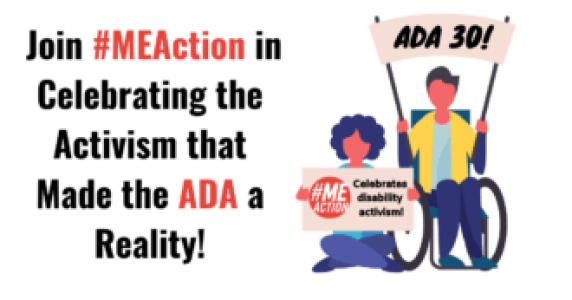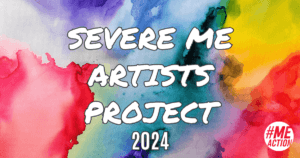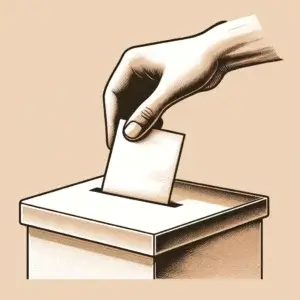30TH ANNIVERSARY OF THE ADA
The celebration of the 30th Anniversary of the Americans with Disability Act (ADA*) is more than a celebration of the day when pen was put to paper in order to sign a bill into law, it is the celebration of the amazing, heroic efforts disability activists took in order to make that day a reality.
The ADA was hard-fought for years on the ground and is able to exist due to the previous efforts throughout the 1970s and 80s. The campaign to force implementation of section 504 of the Rehabilitation Act of 1973 was a major organized effort. One such effort that was powerfully captured in the documentary, Crip Camp, was the Section 504 sit-ins that took place in April 1977. These sit-ins happened in cities across the country. The sit-in in San Francisco lasted 25 days and drew national attention. #MEAction had the privilege of doing a screening of Crip Camp for our community followed by a Q&A with Jim LeBrecht, Nicole Newnham, Judy Heumann and moderated by our own Jen Brea. You can watch that here.
A critical protest specific to the passing of the ADA was the “Wheel of Justice March” that ended with the “Capitol Crawl”. In March 1990 the ADA was stalling in Congress, so ADAPT activists and others gathered to march down Pennsylvania towards the Capitol. Upon reaching the capitol and after listening to speakers, activists began crawling up the 78 steps of the Capitol Building. This event illustrated the real barriers and lack of access for people with disabilities while also illustrating that nothing will stand in the way of activists achieving their civil rights.

As well as protests, numerous advocates and activists were instrumental in the building and passage of the ADA. We cannot possibly mention them all in our brief history but we do want to recognize Justin Dart, widely known as the “father of the ADA.” President Reagan selected Dart to be the vice-chair of the National Council on Disability in 1981. Justin and his wife Yoshiko traveled to all 50 states twice gathering the stories of people with disabilities. Upon receiving these stories of injustice and discrimination, Senator Tom Harkin from Iowa worked with other prominent leaders to author the ADA. Justin Dart was on stage with President Bush when he signed the ADA into law.

Through the years, there were and continue to be many protests in which disability activists demanded change and continued to apply pressure to local and federal government. These are just a few examples of how disability activists used direct activism to move the needle in their fight for their rights and equal treatment under the law. And while the ADA is not perfect and there is still much work to be done to ensure civil rights for all types of disabilities, we want to spend this day recognizing how when ideas become action, change follows.
Here are stories for MEAction Staff that highlight the importance of learning from these activists and how the ADA has provided access in their lives:
Ben: I’m inspired by the work of activists that led to the disability rights milestone of the passage of the ADA thirty years ago. It shows generations of future activists that we can and must continue to root out discrimination, exclusion and stigma from our society, and reshape it around a vision of inclusion, dignity and rights for all people. When marginalized people work together we can change the terms upon which our government has mistreated us. My chronic disease may be “invisible” but I shouldn’t have to be. All of us can get sick. All of us can become disabled. All of us deserve a government that protects and provides for our full participation in society as equals. (P.S. I highly recommend Being Heumann: An Unrepentant Memoir of a Disability Rights Activist which I just finished on audiobook)
Holly: The 30th anniversary is a great time to reflect on the activism that got us here and how far we still have to go. I especially want to send out my appreciation to all the activists who came before and cleared obstacles that I never even realized existed. So to all those activists that fought, crawled, sat-in, wrote letters, or protested however possible, thank you! Your fight to show disabled people as beautifully human and worthy impacts my life in a very real way every day. Your efforts to gain disabled people access to work, education, transportation, buildings, and so much more means that I can have outings with my family that would have not been possible otherwise. Your example helps me know how to continue the fight and to carry that fight on for the next generation.
Erin: I am currently living in an able body and with that comes privileges that for most of my life I took for granted. I had an awareness of accessibility issues, but not a full understanding of the impact these issues had on a person’s day-to-day life. All of that began to change when I worked for a non-profit that was located inside the Disability Empowerment Center (DEC) in Phoenix, Arizona. This office building was fully accessible from the doors, to the bathrooms, to the elevator, to even a sign asking people not to wear strong scents. Right across from the office building was a fully accessible community center. My eyes are now opened to what an accessible world looks like and should look like beyond one office building, one community center, in one city. The activism and determination it took to make the ADA and even the DEC a reality is something to be celebrated and recognized. The direct action these activists took to bring about change, provides a foundation and road map as we continue to fight for a more equal, accessible world for all.
Adriane: The disability rights’ activists who fought for the ADA act not only gave me the opportunity to accommodate my physical disability, it freed me to acknowledge and respect my body’s needs in the first place. There are many times when my husband pushes me home in my son’s stroller from the park because I don’t have enough energy to make it on my own. I’ve experimented with using a wheelchair, which made me shy at first since people largely know me to be ambulatory, and I knew the sudden change would generate stares and questions and confusion. But, I feel no need to explain or justify my disabilities that are sometimes invisible and sometimes in plain sight – and I owe that to the disability rights’ activists who came before me..
You can read Adrian’s full story here.
——
*What is the American Disabilities Act?
“The ADA is one of America’s most comprehensive pieces of civil rights legislation that prohibits discrimination and guarantees that people with disabilities have the same opportunities as everyone else to participate in the mainstream of American life — to enjoy employment opportunities, to purchase goods and services, and to participate in State and local government programs and services. Modeled after the Civil Rights Act of 1964, which prohibits discrimination on the basis of race, color, religion, sex, or national origin – and Section 504 of the Rehabilitation Act of 1973 — the ADA is an “equal opportunity” law for people with disabilities.” – from the ADA Government website.





